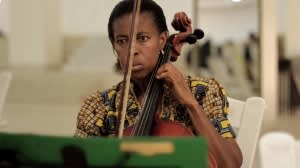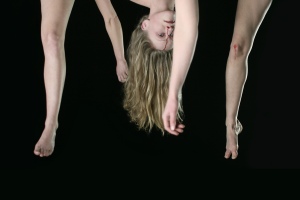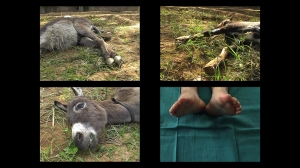
Organized annually since 2009 by the Whitechapel Gallery, Artists’ Film International showcases artists working with film, video and animation, selected by 14 partner organizations around the world and presented over the course of a year at each venue. This is the first season Project 88 has participated, represented by my Minds to Lose, 2008-2011. A series of 8 collaged drawings based on the performance of Petting Zoo and the related video Minds to Lose will be on display. I have selected the following videos, Ana Gallardo’s Estela 1946/2011, 2012, Kaia Hugin’s Five Parts—A Motholic Mobble (Part 5), 2012, and Katarina Zdjelar’s My Lifetime (Malaika), 2012, to show alongside Minds to Lose.
Something which I strive for in my work and which I look for in others is an equal mix of pleasure, anxiety, and comic absurdity. Touching and being touched, in all its senses, seems to be something that can encompass those three valences. Minds to Lose certainly achieved a balance of the three. The selected videos all can be seen encompassing and enlarging on the semantic field of “touch”—touching music, touching bodies, touching emotions and touching madness.
Appropriately , the archaic meaning of touch, from the thirteenth-century vulgate Latin toccare, to knock or strike a bell, is to play on a string instrument. The opening shots of Katarina Zdjelar’s My Lifetime, (Malaika), 2012, show instruments being plucked without sound being produced, and when the orchestra starts up, we see a lone trumpeter struggling to start on time or keep pace.(These instruments, human and mechanical, are the National Symphony Orchestra of Ghana. The video works up a gentle protest against the nationalist fervor inaugurated by Kwame Nkrumah, the first president of the state of Ghana, who established this orchestra in 1959.) The withdrawal of the body when under pressure is nothing new. Yes, musicians are a blessed lot, even a tribe touched by fire. However here in Malaika, we witness the sheer exhaustion of daily life, making the orchestra impossibly out of tune and out of sync. The bodies of the musicians try but fail to inhabit themselves fully. Each musician plays at will, maybe for the pleasure of the activity; but the group fails to harmonize. The anxiety and comedy of their circumstances belie the harsh living conditions that allow scant hours of practice. The musicians’ desire and ability clash, while their bodies sweat or nod off to sleep. Thus we witness a national orchestra performing a famous Swahili love song with as much emotional investment as a stranger to love. The irregular orchestra slumbers and sweats, losing consciousness, checking out from the travails of life.And yet the clash of group effort and individual consciousnesses makes an affecting portrait. Zdjelar’s Malaika shows bodies touching instruments while touched by exhaustion. As viewers we are pleased and uneasy.

Of course, the body could choose to splinter and fight when faced with pressure and when withdrawal is not an option. In Kaia Hugin’s Five Parts—A Motholic Mobble (Part 5), 2012, body parts are all touched, madly, affectingly, physically. The video commences with a head and four limbs descending precipitously and vertically into the blackness of the screen. At first suspended in inertia, the body parts soon twitch in restlessness, intimating the vulnerability of bodies and the hazards body parts can present each other. Suspended limbs start slapping each other, possessed, vicious. It is sad when the protagonist’s head is bloodied, because there is no helping hand amidst all these dangling limbs. She forlornly continues her upside down,wide-eyed watch. Eventually she bites an arm while the sounds of body parts slapping each other continue. If, as Minds to Lose asks, unconsciousness is a body part, then here in Motholic Mobble consciousness is a vicious live animal part. The body parts are fractious, restive, and dangerous, absurdly and comically so. Slapstick meets improv meets choreographed dance meets uncertain fragile skin of body. This tour de force of movement choreography and special-effects makeup is a film made for the screen, where the apparatus holding up all the bodies remains invisible. Hugin’s film references Picasso’s Guernica in its fracturing and distortion of a body, and in the inevitable loss in a battle of flesh. It is also an homage to Maya Deren’s experiments in choreography and film. In Hugin’s Mobble films, the main character goes through a variety of (compulsive) acts: she hangs, levitates, floats, walks backwards, or bores herself into the ground. Motholic Mobble is the first film of here to feature bodies other than her own. Here the group appears coherent if distorted. Time is histrionic, dramatic, linear, full of suspense. Mobble depicts bodies in touch with other bodies, replete with tactility and dangerous stirrings. We are touched delightfully, worryingly, comically.

Watching Ana Gallardo’s Estela 1946/2011, 2012, one is mesmerized by the partial image of bodies captured by a restless jostling camera; but the image tells us only so much, and we are touched to see hands massaging the hand of a wheelchair-bound old lady. Gallardo got to know Estela in a geriatric facility for retired prostitutes in Xochiquetzal, Mexico City, where Ana put in hours of social work. She took care of Estela, a woman paralyzed by several strokes, until Estela died. The film was shot by a neck hung camera, perhaps only to keep the hands free for work, but also lending the film a feeling of being shot on the sly. Once we learn the backstory, Love, Work, Body, Death, all these serious topics come together poignantly through seeing the act of touching. Thus is time unparalyzed and unfrozen by touch. Estela revels in tactile touching, where the paralyzed body of a retired geriatric prostitute is affectingly touched, emotional stirrings touching us. We are also touched pleasurably, anxiously, amusingly.

In my own film Minds to Lose, 2008-2011, one could understand that anesthetizing a group of domesticated animals and a human artist are the act of a person lightly touched with madness. The public performance of the work as Petting Zoo, 2008 invited touch: the grouped bodies were presented as a mentally checked-out petting zoo. In the film, multiple bodies appear and disappear into the black of the screen, multiple bodies share space on-screen, and animal bodies persist even while the presiding consciousness of each disappears to create a darkly anxious comedy. There the body goes. There the body thuds. There she touches the animal skin. It is ever so soft and fleecy. It touches on consciousness, on touching consciousness, on being touched by unconsciousness. The film considers what having a mind and rational consciousness means to a body under general anesthesia. The work is accompanied by a soundtrack of field recordings and fragments of traditional lullaby which addresses body parts associated with thinking and feeling. Using a single-screen with multiple divisions, Minds to Lose creates a forced familial commonality between humans and animals—two goats, one sheep, a donkey, and the artist—as they lose consciousness. It is about wanting to be touched while being out of touch.

This selection speaks to me and to each other, because these works touch on the business of life, what each one of us is bodily coping with and triumphing over and giving in to. The works are of bodies being touched and are about being touched, too.The bodies are all under pressure, stressed to an extreme of vacancy. But the vividness of losing self and also finding oneself again is also played out. Bodies are always either withdrawing, engaging; are charged with disquiet or with charming conflations. Bodies are absurd things. Touched things.
Neha Choksi
Bombay, 2013

